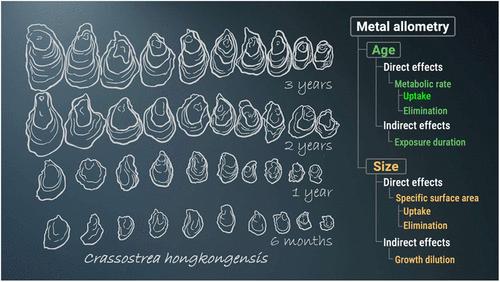自然实验揭示较老牡蛎中较低的金属含量:解开年龄,大小和生长影响
IF 11.3
1区 环境科学与生态学
Q1 ENGINEERING, ENVIRONMENTAL
引用次数: 0
摘要
异速生长描述了生理过程与体型不成比例的比例。这挑战了生物体内金属浓度与环境水平之间存在直接关系的假设,这是生物监测项目中常用的一个前提。然而,破译金属异速生长的复杂驱动因素是困难的,因为尺寸和年龄经常相互混淆。在这项研究中,我们利用了已知年龄的牡蛎种群提供的自然实验,这些牡蛎在同一年龄队列中表现出巨大的尺寸变化。利用稳定的金属同位素示踪技术,研究了六种金属(60Ni, 65Cu, 68Zn, 107Ag, 114Cd, 206Pb)在溶解和饮食暴露下的生物积累。我们的研究结果表明,生物积累效率主要驱动金属浓度的异速模式,年龄的影响比尺寸的影响更明显。年龄较大的牡蛎表现出较弱的生物积累能力,导致金属浓度与大小呈负相关。同时,生长稀释等间接因素作用较小,暴露时间的影响可以忽略不计。这项研究增强了我们对海洋生物中金属生物积累的复杂机制的理解,并为改善生物监测数据的解释提供了重要的见解。本文章由计算机程序翻译,如有差异,请以英文原文为准。

Natural Experiment Reveals Lower Metal Levels in Older Oysters: Disentangling Age, Size, and Growth Effects
Allometry describes the disproportional scaling of physiological processes with the body size. This challenges the assumption of a direct relationship between metal concentrations in organisms and environmental levels, a premise commonly used in biomonitoring programs. However, deciphering the complex drivers of metal allometry is difficult because size and age often confound each other. In this study, we took advantage of a natural experiment provided by populations of oysters of known ages that exhibited substantial size variation within the same age cohorts. Using a stable metal isotope tracer technique, we examined the bioaccumulation of six metals (60Ni, 65Cu, 68Zn, 107Ag, 114Cd, 206Pb) under both dissolved and dietary exposures. Our results indicate that bioaccumulation efficiency primarily drives the allometric patterns of metal concentrations with age exerting a more pronounced influence than size. Older oysters showed a diminished bioaccumulation capacity, leading to negative correlations between the metal concentration and size. Meanwhile, indirect factors, such as growth dilution, played a minor role, and exposure duration had a negligible effect. This study enhances our understanding of the complex mechanisms governing metal bioaccumulation in marine organisms and provides critical insights into improving the interpretation of biomonitoring data.
求助全文
通过发布文献求助,成功后即可免费获取论文全文。
去求助
来源期刊

环境科学与技术
环境科学-工程:环境
CiteScore
17.50
自引率
9.60%
发文量
12359
审稿时长
2.8 months
期刊介绍:
Environmental Science & Technology (ES&T) is a co-sponsored academic and technical magazine by the Hubei Provincial Environmental Protection Bureau and the Hubei Provincial Academy of Environmental Sciences.
Environmental Science & Technology (ES&T) holds the status of Chinese core journals, scientific papers source journals of China, Chinese Science Citation Database source journals, and Chinese Academic Journal Comprehensive Evaluation Database source journals. This publication focuses on the academic field of environmental protection, featuring articles related to environmental protection and technical advancements.
 求助内容:
求助内容: 应助结果提醒方式:
应助结果提醒方式:


